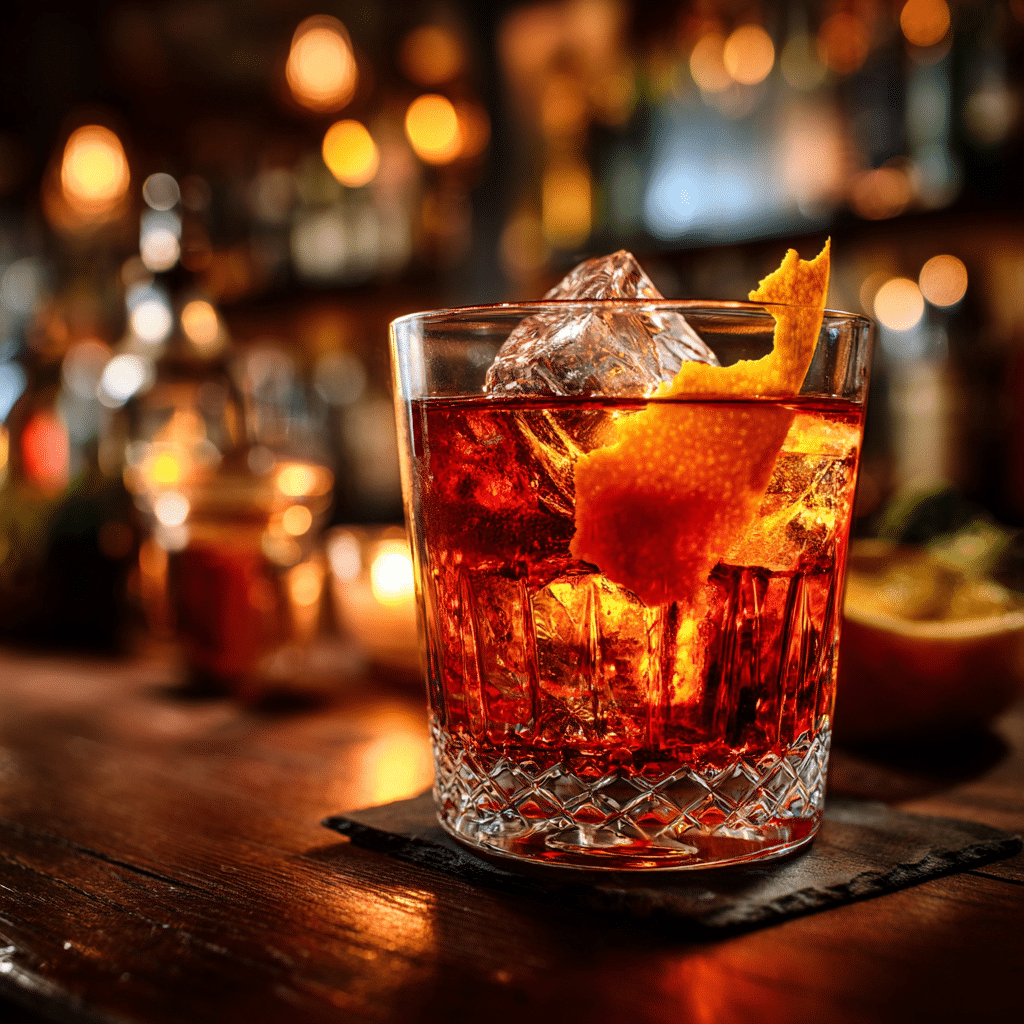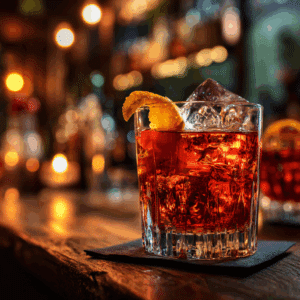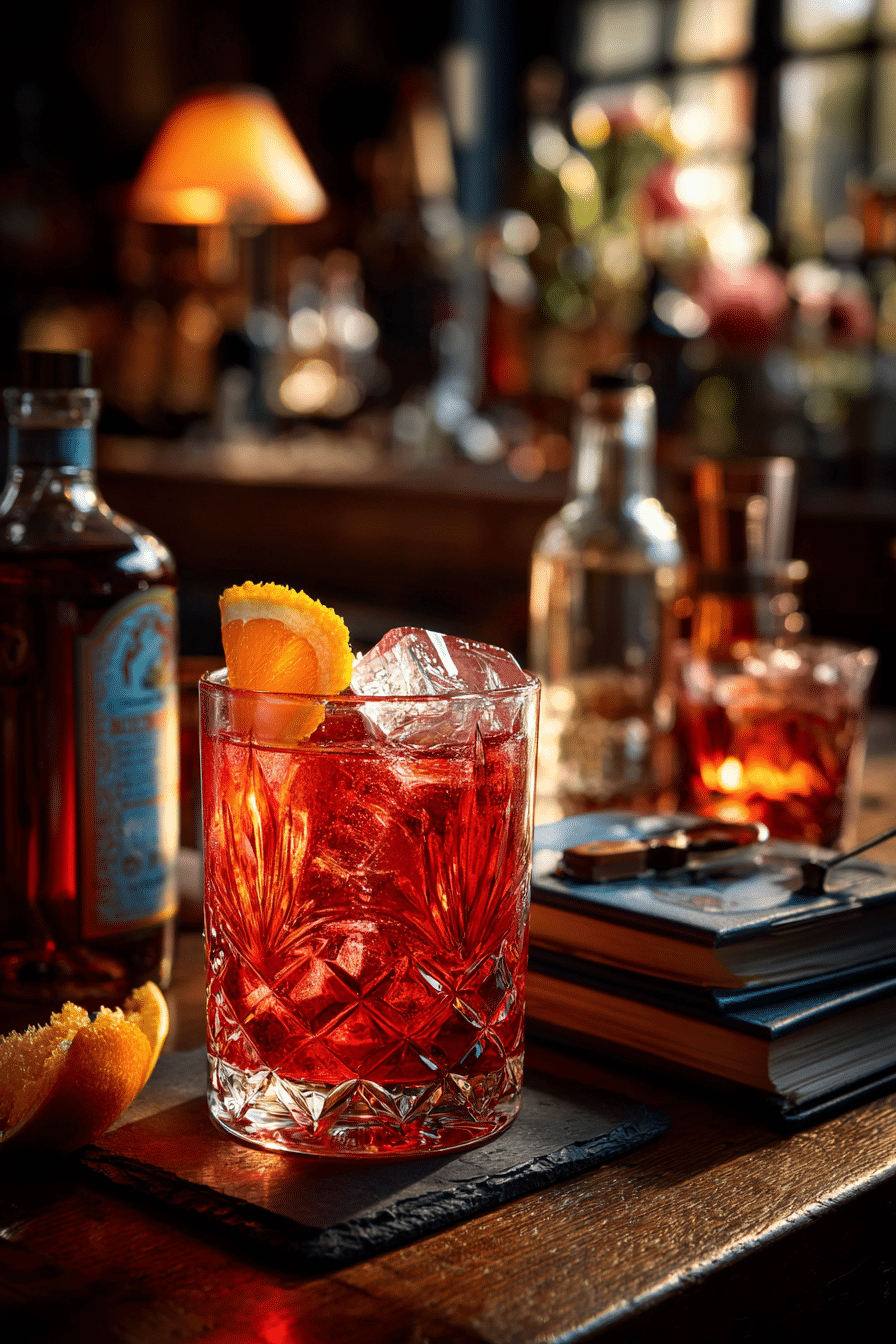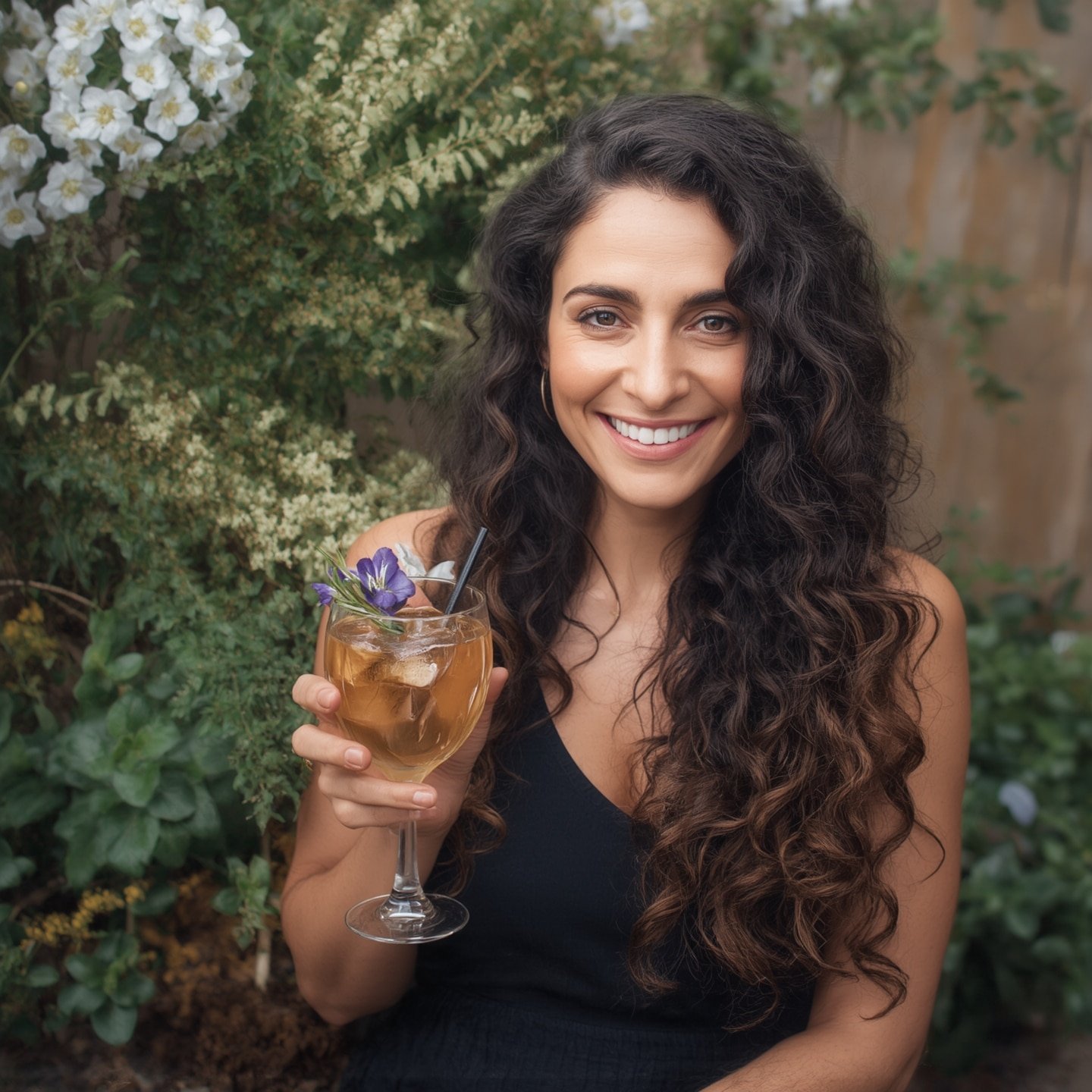There’s something quietly rebellious about crafting a non-alcoholic Negroni. It’s not a drink you sip just to fit in — it’s one you choose on purpose. I remember making my first one for a backyard wedding near Acadia. The bride wanted all guests — including non-drinkers — to have something beautiful in hand. No watered-down soda. No sugar bombs. Just flavor, complexity, and that iconic bitter orange glow. That night, I served my first batch of zero-proof Negronis. A curious uncle took one sip, paused, and said, “Wait… this doesn’t have gin in it?” That’s when I knew we were onto something real.
Table of Contents
Non-Alcoholic Negroni
Equipment
- mixing glass
- bar spoon
- strainer
- rocks glass
- peeler
Ingredients
- 1 oz Monday Zero Alcohol Gin
- 1 oz Giffard Aperitif Syrup (or similar non-alcoholic bitter)
- 1 oz Lyre’s Apéritif Rosso
- 1 Orange peel, for garnish
- 1 Large ice cube
Instructions
- Add all liquid ingredients into a mixing glass with ice.
- Stir gently for 15–20 seconds until well chilled.
- Strain into a rocks glass over a large ice cube.
- Express orange peel over the glass and drop it in.
Notes
Nutrition
Bitter, Bold, and Balanced — The Essence of a Non-Alcoholic Negroni
Why the Negroni Is Hard to Imitate Without Alcohol
The classic Negroni is all about assertiveness. Gin, sweet vermouth, and Campari come together in equal parts — each ingredient pulling its weight. When you remove the alcohol, though, the structure collapses unless you’re deliberate about replacements. It’s not enough to grab any red soda and call it a day.
A proper non-alcoholic Negroni needs three key things: bitterness, aromatics, and viscosity. That means carefully selected components like Monday Gin or Lyre’s Apéritif Rosso — ingredients that bring more than just color to the glass. What gives this mocktail its depth isn’t sugar; it’s nuance. In fact, many of the best versions contain no sweeteners at all beyond what’s naturally present in the spirit alternatives.
On that note, if you enjoy recipes with depth and a strong citrus backbone, you might also want to try my blood orange mocktail spritzer or orange mocktail recipe — both are proof that complex doesn’t mean complicated.
The Real Challenge: Replacing Campari Without Losing the Soul
Campari is bitter, herbal, and unforgettable. It’s also the most stubborn element to replace. In my tests, Sanbittèr came close but added unwanted fizz. Most “Italian Orange” non-alcoholic aperitivos tasted sweet and flat. The breakthrough came when I tried Giffard Aperitif Syrup — thick, bitter, and full of gentian and orange peel. While it doesn’t have Campari’s exact edge, it brings the right attitude to the glass.
Here’s the catch: bitters like Regan’s or Bitter Truth can help finish the drink, but they do contain alcohol. Even a few dashes can bump your ABV above the 0.5% legal threshold for “non-alcoholic.” That’s why I often leave them out entirely or opt for micro-doses. And if you’re going fully alcohol-free for pregnancy, health, or recovery, I recommend skipping them altogether.
Looking to explore other non-alcoholic recipes with a little bite and backbone? My basil mojito mocktail and hydrating tropical mocktails strike a balance between freshness and depth — no alcohol needed.
Building a Better Non-Alcoholic Negroni — One Spirit at a Time
Gin Alternatives That Actually Deliver
A non-alcoholic Negroni can’t succeed without a gin that pulls its weight. It’s not just about juniper. You need something with backbone — botanicals, citrus, even a touch of spice. After months of experimenting (and a few too many “soapy” misfires), my favorite remains Monday Zero Alcohol Gin. It’s aromatic, with real texture. You get that signature dry finish and lingering bitterness that so many non-alcoholic gins lack.
If you’re after something with a softer edge, Lyre’s Dry London Spirit also works beautifully, especially when paired with a bright aperitif. It’s more floral, with less bite — great for those easing into the Negroni style. For a tropical spin, you could even swap in a botanical-forward base like the one I use in this virgin Mai Tai mocktail — it layers surprisingly well.
No matter the base, what matters most is balance. A weak or watery gin replacement will collapse under the bold flavors of your bitters and aperitif. The best non-alcoholic Negroni drinks don’t just avoid alcohol — they stand up without it.
Vermouth Replacements That Add Sweetness, Not Syrup
Traditional vermouth brings sweetness, herbs, and a touch of wine tannin to a classic Negroni. For a non-alcoholic Negroni, that complexity is tough to recreate — but not impossible.
The standout? Lyre’s Apéritif Rosso. It smells like vermouth. Tastes like vermouth. And blends effortlessly with your other ingredients. Hints of vanilla, clove, and bitter orange bring a lovely balance. Some tasters even preferred it over the real thing.
Other solid options include Versin and Blutul, but they’re not as easy to source in the U.S. For those on a tighter budget or exploring, you can even craft a quick red syrup base using pomegranate, spice, and a splash of orange — similar to what I use in this cranberry sangria mocktail recipe. It won’t be traditional, but it works.
Together, your choice of non-alcoholic gin and vermouth will define your cocktail. Don’t settle. A proper non-alcoholic Negroni deserves structure and complexity — not a shortcut.
How to Make a Non-Alcoholic Negroni (With Ingredient Tiers)
Step-by-Step Method for a Perfect Pour
Creating a satisfying non-alcoholic Negroni starts with balance. While the traditional cocktail is an easy 1:1:1 ratio, your spirit alternatives might behave a little differently. Here’s a tested formula that gets close to the real thing without compromising on flavor:
Ingredients:
- 1 oz Monday Zero Alcohol Gin
- 1 oz Giffard Aperitif Syrup (or similar bitter)
- 1 oz Lyre’s Apéritif Rosso
- Orange peel, for garnish
- Ice
Instructions:
- Add all liquid ingredients into a mixing glass with ice.
- Stir gently for 15–20 seconds until well chilled.
- Strain into a rocks glass over a large ice cube.
- Express orange peel over the glass and drop it in.
Want a version that feels a little brighter? Try a 3:2:2 ratio (more gin, less syrup/vermouth) — especially if you’re using a more intense bitter base like Æcorn Bitter or a pomegranate-forward syrup as seen in my very berry mocktail.
Shop the Recipe: Tiered Non-Alcoholic Negroni Picks
To help you get started (or upgrade your setup), here are three complete ingredient pairings. Each creates a different take on the non-alcoholic Negroni — from classic to creative.
Best Overall (Closest to the Real Thing)
- Gin: Monday Zero Alcohol Gin
- Bitter: Giffard Aperitif Syrup
- Vermouth: Lyre’s Apéritif Rosso
Budget-Friendly
- Gin: Ritual Zero Proof Gin Alternative
- Bitter: Sanbittèr (Italian red soda, slightly fizzy)
- Vermouth: Homemade pomegranate-vanilla syrup
Adventurous & Artisanal
- Gin: ISH London Botanical Spirit
- Bitter: Gnista Floral Wormwood
- Vermouth: Blutul (if available)
If you’re exploring beyond the Negroni but still want drinks that offer aromatic complexity, don’t miss my tropical mocktail ingredients guide or this citrus ginger mocktail that also balances bold flavors with subtle sweetness.
Remember, a great non-alcoholic Negroni isn’t just about mimicking booze — it’s about honoring flavor.
FAQs About Non-Alcoholic Negronis
What is a non-alcoholic Negroni called?
It’s often called a “Nogroni” or simply a non-alcoholic Negroni. Some bartenders also use names like NAgroni or Zero-Proof Negroni, though there’s no official term. These versions maintain the drink’s iconic structure but use non-alcoholic spirits and aperitifs.
How to make a no alcohol Negroni?
To make a no alcohol Negroni, mix 1 oz non-alcoholic gin, 1 oz non-alcoholic bitter (like Giffard Aperitif Syrup), and 1 oz non-alcoholic vermouth (such as Lyre’s Apéritif Rosso). Stir with ice and garnish with orange peel. Skip bitters entirely if you want to keep the ABV below 0.5%.
What is a non-alcoholic substitute for Campari?
The best Campari substitute for a non-alcoholic Negroni is Giffard Aperitif Syrup. It brings bitterness, orange peel flavor, and proper thickness. Other options include Æcorn Bitter and Sanbittèr, though the latter adds carbonation.
What is in a virgin Negroni?
A virgin Negroni contains non-alcoholic gin, a bitter aperitif replacement, and a non-alcoholic sweet vermouth. These mimic the original Negroni’s flavor without the alcohol. Ingredients vary, but good options include Monday Gin, Giffard Aperitif, and Lyre’s Rosso.
Final Pour: Why a Non-Alcoholic Negroni Is More Than a Substitute
The non-alcoholic Negroni isn’t just an imitation. It’s a choice. A bold, bittersweet, complex cocktail that respects tradition while embracing change. When made thoughtfully, it satisfies both the flavor purist and the wellness-conscious drinker.
Whether you’re sipping it by the fireplace or serving it to a crowd, this mocktail holds its own. It’s not trying to be a lesser version of something else — it’s its own moment. So next time someone asks, “Why bother making a Negroni without the alcohol?” — just pour them one.
And if you’re planning a full zero-proof spread, round it out with a Christmas sangria mocktail or this fruity sunrise mocktail recipe that balances citrus and spice with beautiful color.
Cheers — to flavor without compromise.





